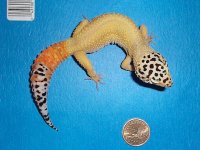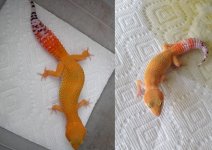What Michele said is correct. To add to or simply repeat what has been said:
When it comes to heterozygous animals, they either are or are not carrying a trait - it is that simple. I'll break this down by the genetics you've provided.
In the case of HTCTB (=hypo tangerine carrot-tail baldy) you're dealing with both selectively bred traits (tangerine and carrot-tail to some extent) and co-dominant traits in the form of hypo baldy. Back in the 1990s all we had were tangerines and hypo tangerines, all from selectively breeding for reduced black spotting and increased orange coloration. Somewhere around 1999 or 2000 a gentleman in the UK produced what was once called the Ray Hine or Hine-line hypo. This was a co-dominant trait, where fully recessive geckos for the most part look relatively normal, the heterozygous form can have or completely lack body spotting but will have a spotted head and tail, and the full dominant form will be virtually spotless on the head and body. Additionally the carrot-tail trait also tied into the Hine-line hypo mutation. It too could be argued co-dominant, but is selectively bred in the capacity as to how much orange is present for the "carrot-tail". The general cut-off back then was that a gecko needed to have genetic lineage traced back to the Hine-line and at least 25% of the tail needed to be orange. Some normal and/or non-Hine-line based animals can and do develop some orange coloration at the base of the tail and it may or may not fade with age.
In this case, your breeding will produce variations of what the adults look like and all hatchlings should be hypo tangerine carrot-tail baldy, or what was once and is still called Super Hypo Tangerine Carrot-tail Baldy (SHTCTB).
Now as for the Tremper albino genetics. As you've stated, the gecko you're getting is listed as 66% het Tremper albino. All three strains of albinism (Tremper, Rainwater, & Bell) are simple Mendelian-based recessive mutations and are also incompatible with one another; that is, in order for either strain, or any recessive mutation, to be expressed the gecko needs to have 2 copies of the albino allele to activate the gene to be visibly expressed. In the case of your future 66% het Tremper albino SHTCTB, again just focusing on the Tremper albino gene, it's parents were both heterozygous for Tremper albino. You'll see such animals listed as het, heterozygous, 100% het or 100% heterozygous. Which brings me back to the statement, the animal is either het or it isn't. You can get additional percentages, but for simplicity there are 3 percentages usually listed in ads:
- het, heterozygous, 100% het, or 100% heterozygous
- 66% het or 66% possible het
- 50% het or 50% possible het
In regards to 66% and 50%, the term "possible" should be included in defining the genetics as that's what is going on genetically - they are possibily het and the 66% or 50% indicate the statistical probability of it being heterozygous or not; whereas an animal listed as het is indicating it is definitely carrying the trait. A 66%
possible het occurs from breeding 2 heterozygous animals together. Genotypically (=what genes they will have), this pairing should yield a 1:2:1 ratio of normal : heterozygous : albino. However, phenotypically (=what is visibly expressed) the ratio changes to 3:1 normal : albino since in the case of a recessive, heterozygotes look the same as their normal sibling(s). Of those 3 "normal" siblings, 2 or 66% have the
possibility of carrying the albino gene - thus the term 66% het or 66% possible het. 50% het or 50% possible het applies similarly, but instead only 1 parent is heterozygous for a recessive mutation and the other parent is completely normal (=dominant or wild-type). Such a pairing results in a 1:1 ratio of genotype (2 heterozygotes : 2 normal) and a 4:0 ratio of phenotype (4 normal). Of these 4 offspring, 2 are heterozygous, thus 50% het or 50% possible het.
Hopefully this long answer gives you a more simplified and clearer understanding. And for giggles, here's what my original Ray Hine Line carrot-tail looked like in the attachment below. She came from Albey Scholl of Albey's Too Cool Reptiles and as you can see she's of the heterozygous form having spotting on her head, versus the super form which are bald or baldy.
View attachment 32585




